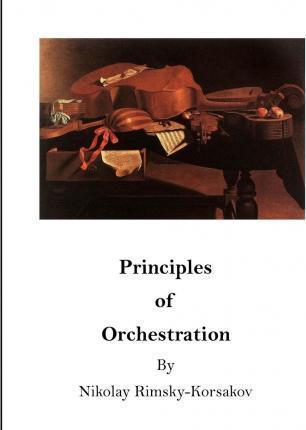Principles of Orchestration: The Age of Brilliance and Imaginative Quality

Principles of Orchestration: The Age of Brilliance and Imaginative Quality
Principles of Orchestration
By Nikolay Rimsky-Korsakov
Edited by Maximilian Steinberg
English translation by Edward Agate
Rimsky-Korsakov had long been engrossed in his treatise on orchestration. We have in our possession a thick note book of some 200 pages in fine hand writing, dating from the years 1873-1874, containing a monograph on the question of acoustics, a classification of wind instruments and a detailed description of the construction and fingering of the different kinds of flute, the oboe, clarinet and horn.
In his "Memoirs of my musical life" (1st edition, p. 120) the following passage occurs: "I had planned to devote all my energies to the compilation of a full treatise on orchestration. To this end I made several rough copies, jotting down explanatory notes detailing the technique of different instruments. What I intended to present to the world on this subject, was to include everything. The writing of this treatise, or, to be more exact, the sketch for it took up most of my time in the years 1873 and 1874. After reading the works of Tyndall and Helmholtz, I framed an introduction to my work, in which I endeavoured to expound the laws of acoustics as applied to the principles governing the construction of musical instruments. My manual was to begin with a detailed list of instruments, classified in groups and tabulated, including a description of the various systems in use at the present day. I had not yet thought of the second part of the book which was to be devoted to instruments in combination. But I soon realised that I had gone too far. With wind instruments in particular, the different systems were innumerable, and each manufacturer favoured his own pet theory. By the addition of a certain key the maker endowed his instrument with the possibility of a new trill, and-VIII- made some difficult passages more playable than on an instrument of another kind.
PRP: 92.61 Lei
Acesta este Prețul Recomandat de Producător. Prețul de vânzare al produsului este afișat mai jos.
74.09Lei
74.09Lei
92.61 LeiLivrare in 2-4 saptamani
Descrierea produsului
Principles of Orchestration
By Nikolay Rimsky-Korsakov
Edited by Maximilian Steinberg
English translation by Edward Agate
Rimsky-Korsakov had long been engrossed in his treatise on orchestration. We have in our possession a thick note book of some 200 pages in fine hand writing, dating from the years 1873-1874, containing a monograph on the question of acoustics, a classification of wind instruments and a detailed description of the construction and fingering of the different kinds of flute, the oboe, clarinet and horn.
In his "Memoirs of my musical life" (1st edition, p. 120) the following passage occurs: "I had planned to devote all my energies to the compilation of a full treatise on orchestration. To this end I made several rough copies, jotting down explanatory notes detailing the technique of different instruments. What I intended to present to the world on this subject, was to include everything. The writing of this treatise, or, to be more exact, the sketch for it took up most of my time in the years 1873 and 1874. After reading the works of Tyndall and Helmholtz, I framed an introduction to my work, in which I endeavoured to expound the laws of acoustics as applied to the principles governing the construction of musical instruments. My manual was to begin with a detailed list of instruments, classified in groups and tabulated, including a description of the various systems in use at the present day. I had not yet thought of the second part of the book which was to be devoted to instruments in combination. But I soon realised that I had gone too far. With wind instruments in particular, the different systems were innumerable, and each manufacturer favoured his own pet theory. By the addition of a certain key the maker endowed his instrument with the possibility of a new trill, and-VIII- made some difficult passages more playable than on an instrument of another kind.
Detaliile produsului









